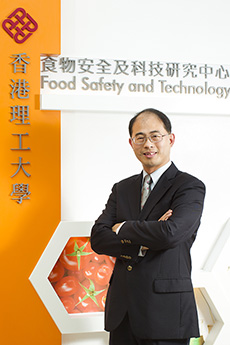PolyU’s Food Safety and Technology Research Centre (Shenzhen branch) has recently been approved to set up the State Key Laboratory of Food Biological Safety Control in Shenzhen. In this issue, Prof. Wong Wing-tak, Head of the Department of Applied Biology and Chemical Technology and Director of the Food Safety and Technology Research Centre, shared his views on food safety in Guangdong and Hong Kong as well as the development of the Key Laboratory.
What are your views on food safety in Guangdong and Hong Kong?
Every year, Hong Kong imports a large number of food from the Chinese mainland. Hence, the quality of these imported food directly affects the health of Hong Kong citizens. In the mainland, conscienceless food incidents involving swill milk, gutter oil, meat additive, malachite green etc. occurred frequently. This has triggered public concern about food safety. Recent years saw the food-borne bacterial pathogens and toxins increasingly threatening the human health. Such risks, however, have often been disregarded in the mainland due to the weak research base and lack of quick detection and control measures of food safety.
To upgrade food safety standards in the Pearl River Delta (PRD) areas, PolyU’s Food Safety and Technology Research Centre established a laboratory in Shenzhen in 2011. Accredited by the Shenzhen Government, the laboratory has recently been elevated to a Key Laboratory to conduct food safety testing and research within the PRD.
How would the Key Laboratory help enhance the food safety standards?
Research is an indispensable step for technological advancement. Every year, we will collect some 5,000 food samples of meat, dairy and aquatic products from supermarkets and wet markets in Shenzhen, Guangzhou and Hong Kong. The food samples will then be tested and analyzed for eight major pathogens including Salmonella and Escherichia coli.
Establishing risks evaluation and early warning system on food safety is our top priority. We should conduct state and risk analysis on various kinds of food contaminated with food-borne pathogenic bacteria, toxins and prohibited chemical contaminants; and identify their serotypes, subtypes, drug resistance and pathogenicity for further investigation. Major bacterial pathogens that possibly cause food poisoning, outbreak and infection in those three regions can thus be predicted.
How can food authentication be enhanced?
We wish to develop a portable DNA biosensor for bacterial pathogen detection so that microbiological tests can be conducted instantly and on the spot for food authentication. We will also study how such testing platforms conduct rapid tests on various pathogens and align with conventional testing.
Are there any new technologies on food processing and storage?
As for food processing and storage, we are developing a low cost new technology for food packaging film made by corn protein. With improved stretchability, barrier and anti-bacterial performance, the new food packaging film may replace plastic packaging for the food that absorbs plasticizer easily.
What is the research goal of the Key Laboratory?
In the future, the research findings of the Key Laboratory will be compiled into a food safety database of the PRD region for reference in related research and risks management. The industry can make reference to the data to identify high-risk food and explore measures to tackle related problems. Our ultimate objective is to improve food safety standard so that public can enjoy the food from Guangdong and Hong Kong with research-based quality assurance.

